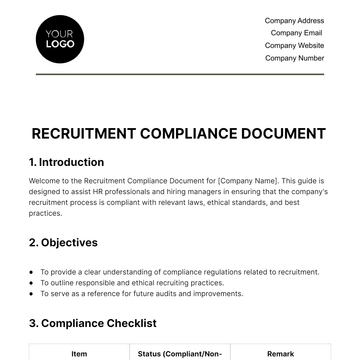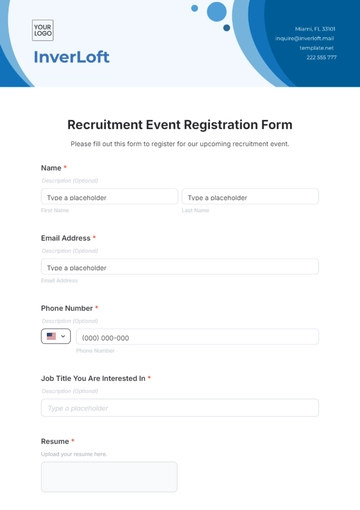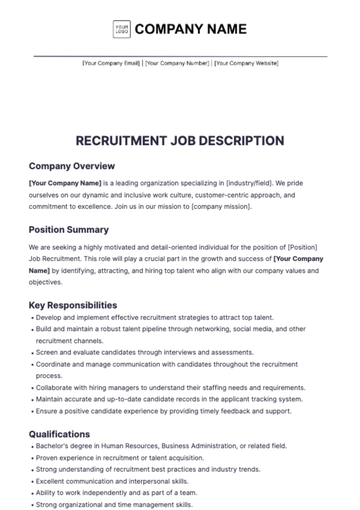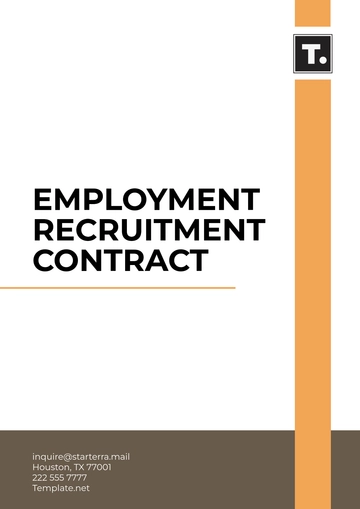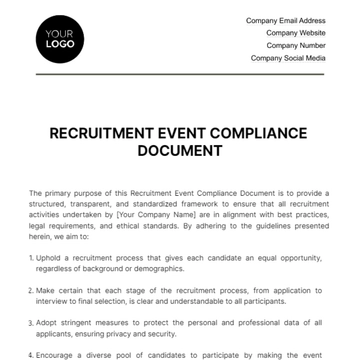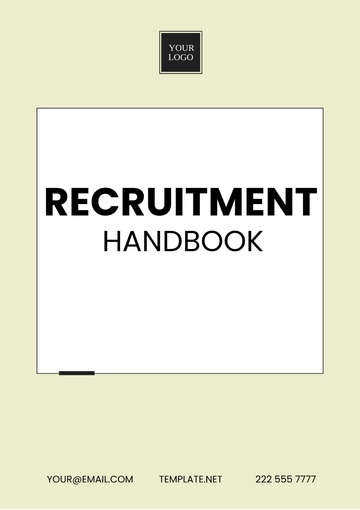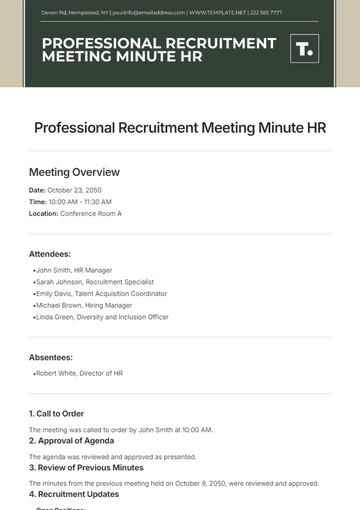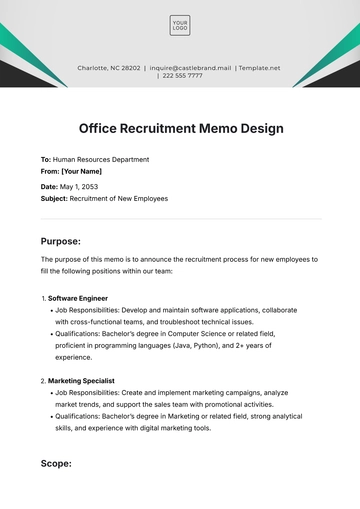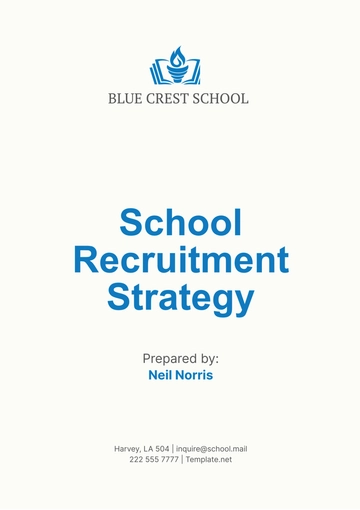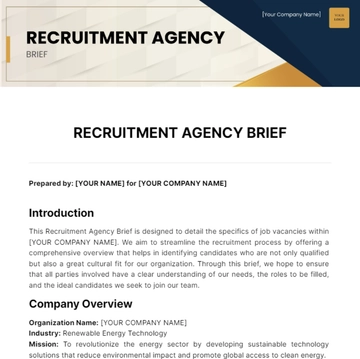Free Recruitment Vendor Management Guide HR
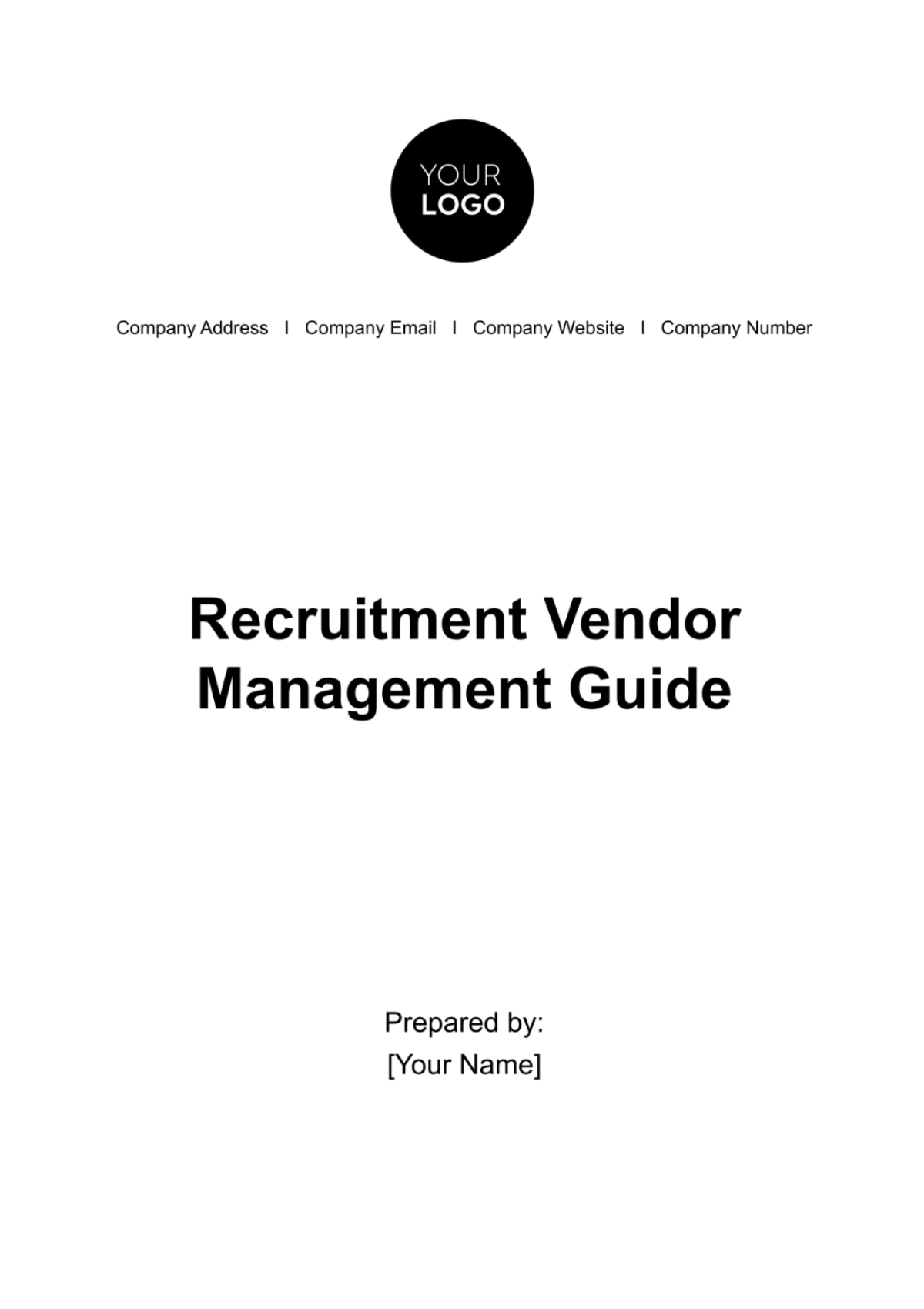
Table of Contents
1. Executive Summary ...........................................................................................2
2. Introduction .......................................................................................................3
3. Objectives .........................................................................................................3
4. Vendor Identification ........................................................................................5
5. Vendor Evaluation .............................................................................................5
5.1 Qualitative Assessment ..................................................................................6
5.2 Quantitative Assessment ...............................................................................6
6. Contract Negotiation .........................................................................................7
7. Vendor Onboarding ............................................................................................7
8. Vendor Performance Metrics ...........................................................................8
9. Ongoing Relationship Management .................................................................9
10. Termination Procedures ................................................................................10
11. Appendices ....................................................................................................10
Executive Summary
The Recruitment Vendor Management Guide is a comprehensive handbook designed to standardize and optimize the process of managing recruitment vendors at Human Resources Inc. In the highly competitive landscape of talent acquisition, selecting and managing the right recruitment vendors is of paramount importance. This guide aims to serve as an end-to-end solution, offering an extensive framework that touches upon all key facets of the vendor management lifecycle.
The document is structured to provide a logical flow, beginning with the initial stages of vendor identification. It outlines the specific criteria to look for, ensuring that only the most qualified and competent vendors are considered. From there, the guide delves into the intricate details of vendor evaluation, focusing on both qualitative and quantitative metrics to offer a well-rounded view. It addresses how to conduct evaluations, what criteria to use, and how to make informed decisions based on these assessments.
Once a vendor has been identified and evaluated, the guide transitions into the contractual aspects, elucidating best practices for contract negotiation. It offers insights into setting appropriate term lengths, payment terms, and service level agreements (SLAs) that align with both parties' expectations.
The guide also provides robust procedures for the onboarding process, ensuring a smooth transition for both the company and the vendor. Detailed performance metrics and Key Performance Indicators (KPIs) are included to continuously monitor and assess the quality, efficiency, and effectiveness of the vendor's services.
For sustaining long-term partnerships, the guide offers advice on ongoing relationship management through periodic reviews, meetings, and audits. In the event that a vendor relationship needs to be terminated, detailed procedures are provided to ensure that the process occurs in a professional and amicable manner, thereby minimizing disruptions to business operations.
In essence, this guide acts as a strategic roadmap for Human Resources Inc., offering a structured, analytical, and informed approach to managing recruitment vendors. By following the guidelines set forth in this document, the company can ensure a harmonious, efficient, and effective vendor management process that resonates with its organizational goals and objectives.
Introduction
In the current business environment, where talent is a significant differentiator, the importance of efficient and effective recruiting cannot be overstated. Given that quality talent acquisition is integral to the success of any organization, it's vital to partner with recruitment vendors that not only understand this but actively contribute to achieving this objective. However, navigating the complexities of vendor management can be challenging, with varied performance metrics, contract terms, and relationship dynamics to consider. This is where the Recruitment Vendor Management Guide comes into play.
The primary goal of this guide is to provide Human Resources Inc. with a systematic approach for managing recruitment vendors. This document serves as a practical tool, offering a step-by-step guide that covers the entire vendor management lifecycle—from identification and evaluation to onboarding, performance monitoring, and, if necessary, termination. It is engineered to remove the guesswork from the equation, providing a set of best practices and standardized procedures designed to ensure consistency and excellence in the vendor management process.
By streamlining vendor management operations, Human Resources Inc. aims to form strategic partnerships with the most qualified vendors in the industry. These partnerships will not only drive efficiency but also significantly contribute to achieving business objectives. With carefully vetted vendors that align with organizational values and goals, Human Resources Inc. is better positioned to attract top-tier talent, thereby gaining a competitive edge in the marketplace. This guide serves as the cornerstone for establishing and maintaining these valuable vendor relationships.
Objectives
The Recruitment Vendor Management Guide has several key objectives, each designed to provide Human Resources Inc. with a comprehensive understanding and actionable steps for managing recruitment vendors effectively. Below are the detailed objectives:
Establish Criteria for Vendor Identification
To create a standardized set of criteria that helps in identifying potential vendors who can meet the organization's specific needs. This will involve aspects like industry experience, client references, and pricing models. The objective is to formulate a checklist that acts as a preliminary screening tool, ensuring that only vendors with proven capabilities are considered for further evaluation.
Outline Evaluation Metrics
To provide a robust framework for assessing the shortlisted vendors, incorporating both qualitative and quantitative metrics. This will include factors like culture fit, communication skills, problem-solving abilities, and key performance indicators like time-to-hire, cost-per-hire, and quality-of-hire. The aim is to offer a balanced and comprehensive evaluation process that allows for well-informed decision-making.
Detail Contract Negotiation Best Practices
To outline the essential components that should be present in any vendor contract, emphasizing the importance of term lengths, payment terms, and service level agreements (SLAs). This objective is focused on ensuring that contracts are fair, transparent, and beneficial to both parties while minimizing risks and ambiguities.
Provide Guidelines for Vendor Performance Tracking
To establish a system for continuous performance assessment once a vendor is onboarded. The objective is to define key performance metrics and set up regular reporting mechanisms. This ensures that the vendor is meeting the agreed-upon standards and allows for timely interventions if performance starts to decline.
Describe Relationship Management and Termination Protocols
To elucidate the steps involved in maintaining a healthy, long-term relationship with vendors through periodic reviews, meetings, and performance audits. Additionally, to set forth the procedures for terminating a vendor contract, should the relationship prove unsatisfactory or if organizational needs change. The aim is to manage both the ongoing and potential end of vendor relationships in a professional, ethical, and amicable manner.
By meeting these objectives, this guide will serve as a comprehensive tool for ensuring that vendor management at Human Resources Inc. is conducted in an effective, efficient, and strategic manner.
Vendor Identification
The first critical step in effective vendor management is identifying potential vendors who align with the company's needs and objectives. By establishing clear criteria for vendor identification, Human Resources Inc. can streamline the selection process and ensure that only the most competent vendors are considered for partnership. This section outlines the key criteria that should be used for preliminary vendor identification and explains the importance of each.
Criteria | Description |
Industry Experience | Number of years in the recruitment business |
Client References | Previous client reviews and ratings |
Pricing | Compatibility with budget constraints |
Vendor Evaluation
Vendor evaluation is a critical component of effective vendor management. This step not only helps to identify the best vendors for your business needs but also ensures that they continue to meet or exceed expectations over time. Here are some key areas to consider for both qualitative and quantitative assessments:
Qualitative Assessment
Culture Fit: Culture fit is crucial in ensuring that the vendor aligns well with your company’s values, ethos, and working style. A strong culture fit can lead to more effective communication, better service, and a more harmonious business relationship. It can often predict the long-term viability and success of the vendor partnership.
Communication Skills: Effective communication is vital for any successful vendor relationship. This involves not only clarity and accuracy but also the timeliness and appropriateness of communication. A vendor that communicates well is likely to be more reliable and easier to work with, thereby making the project run more smoothly.
Problem-solving Abilities: Every project encounters challenges. A vendor with strong problem-solving skills can help turn these challenges into opportunities for improvement. Evaluate a vendor's ability to provide solutions under pressure, adapt to changes, and proactively address issues before they become significant problems.
Quantitative Assessment
Average time-to-hire: This metric measures the average time it takes for the vendor to complete the hiring process, from job posting to the successful onboarding of a candidate. A shorter average time-to-hire is generally favorable, as it indicates efficiency but should not compromise the quality of hires.
Cost-per-hire: Cost-per-hire quantifies the average expense involved in hiring a new employee through the vendor. This includes advertising expenses, screening costs, and any other associated costs. Lower cost-per-hire figures are generally favorable but should be balanced against the quality and longevity of hires.
Quality-of-hire: This is a critical metric that evaluates the performance and the value a new hire brings to the company. It can be measured through performance reviews, the accomplishment of set objectives, or the new hire’s impact on team productivity. A high quality-of-hire ratio suggests the vendor is effective in sourcing candidates who are not only qualified but also impactful.
Through comprehensive qualitative and quantitative evaluations, you can ensure that you are selecting the most suitable, reliable, and cost-effective vendors for your recruitment needs.
Contract Negotiation
Component | Consideration |
Term Length | Minimum 1 year, with options for renewal |
Payment Terms | Net 30 payment terms |
Service Level Agreements (SLAs) | Define quality and speed of service |
Vendor Onboarding
Vendor onboarding is a critical step in vendor management, laying the foundation for a successful long-term partnership. It involves various procedures designed to get the vendor up to speed with your company’s processes, expectations, and culture. Below are some key components:
Welcome Package: A welcome package is typically the first formal communication you have with your new vendor. This package can include essential documents, company swag, and introductory materials that outline your company's culture, history, and expectations. The goal is to make the vendor feel valued and provide them with the resources they need to start on the right foot. A well-crafted welcome package can serve as a strong first impression, setting the tone for a collaborative and respectful relationship.
Point of Contact Assignment: Assigning a point of contact (POC) is critical for streamlining communication between your company and the vendor. The POC will be responsible for vendor management activities, including performance reviews, conflict resolution, and routine communications. Assigning a dedicated POC ensures that the vendor knows exactly whom to contact for different issues, thereby avoiding any communication breakdowns. The POC will also be responsible for understanding the vendor’s operations in-depth and how they integrate with your company’s needs.
System Integrations: System integration involves configuring your internal systems—like Enterprise Resource Planning (ERP) or Customer Relationship Management (CRM) software—to communicate with the vendor's systems. Proper system integration allows for smoother workflow, real-time data sharing, and faster decision-making. This part of the onboarding process can be complex, requiring a deep understanding of both your internal systems and those of the vendor. However, effective system integration is vital for maximizing efficiency and ensuring that you get the most value out of your relationship with the vendor.
By taking the time to thoroughly address these key aspects of vendor onboarding, you’re more likely to establish a successful, long-lasting relationship that benefits both parties.
Vendor Performance Metrics
Effectively managing a vendor relationship extends well beyond the initial selection and onboarding process. Continuous monitoring is key to ensuring that the vendor not only meets but also exceeds expectations, thereby adding value to your organization. This is where Vendor Performance Metrics come into play. These metrics serve as quantifiable Key Performance Indicators (KPIs) that can be systematically tracked and analyzed over time. In this section, we will discuss three critical performance metrics—Responsiveness, Quality of Talent, and Client Satisfaction—each tied to specific KPIs designed to evaluate the vendor's overall efficiency and effectiveness in the recruitment process.
Metric | KPI |
Responsiveness | Average response time |
Quality of Talent | Percentage of candidates advancing to the second round |
Client Satisfaction | Ratings in quarterly reviews |
Ongoing Relationship Management
Responsiveness:
KPI: Average response time
Responsiveness is pivotal in maintaining a smooth workflow and ensuring timely project completion. The KPI, average response time, is calculated by measuring the time it takes for the vendor to respond to emails, calls, or any other forms of communication. It can be averaged over a week or a month. A lower average response time is usually preferable, as it indicates that the vendor is attentive and values the importance of clear, prompt communication.Quality of Talent:
KPI: Percentage of candidates advancing to the second round
The ability to recruit high-quality talent is fundamental for any company's success. In this case, the KPI used is the percentage of candidates sourced by the vendor who make it to the second round of interviews. A higher percentage usually signals that the vendor understands your organization's needs and is proficient in sourcing candidates who align well with those needs. This KPI provides an objective measure to evaluate the vendor’s efficacy in providing suitable candidates.Client Satisfaction:
KPI: Ratings in quarterly reviews
Client Satisfaction is a broad metric that encapsulates several aspects of the vendor-client relationship, such as the quality of service, reliability, and adherence to deadlines. The KPI is the average rating received during quarterly reviews, usually on a scale of 1 to 5. A higher average rating indicates overall satisfaction with the vendor’s performance and can serve as a proxy for general reliability and the quality of the delivered services.
Each of these KPIs provides valuable insights into different facets of vendor performance. When combined, they offer a holistic view of the vendor's strengths and areas for improvement, empowering Human Resources Inc. to manage vendor relationships more effectively.
Termination Procedures
Ending a relationship with a vendor is a sensitive process that must be handled with care and precision to minimize disruptions and maintain a professional rapport. Here are key elements in our termination procedures:
Exit Interview: An exit interview serves as a final opportunity to discuss the reasons for termination and gather feedback from both sides. It helps to identify any loose ends and establishes the groundwork for a possible future re-engagement.
Contract Closeout: This involves a formal review of the contract to ensure all obligations have been met. Final payments are processed, and any remaining deliverables are settled, ensuring a clean break without lingering obligations.
Data Transfer: If the vendor holds any company data, a secure data transfer process is initiated. This ensures that all sensitive information is returned and that the vendor no longer has access to it post-termination.
By adhering to these steps, Human Resources Inc. aims to handle vendor terminations in a respectful, transparent, and organized manner.
Appendices
Sample Contracts (As Attachment)
Vendor Evaluation Forms (As Attachment)
Contact List of Approved Vendors (As Attachment)
By adhering to this Recruitment Vendor Management Guide, Human Resources Inc. aims to maintain a high standard of vendor relations that is conducive to achieving the organization’s recruitment goals.
- 100% Customizable, free editor
- Access 1 Million+ Templates, photo’s & graphics
- Download or share as a template
- Click and replace photos, graphics, text, backgrounds
- Resize, crop, AI write & more
- Access advanced editor
This comprehensive Recruitment Vendor Management Guide HR Template is your go-to resource for streamlining vendor interactions in the recruitment process. Designed to simplify complex procedures, it covers vendor identification, performance metrics, and termination protocols. Features include customizable sections and checklists for ease of use. Elevate your vendor management strategy today.
